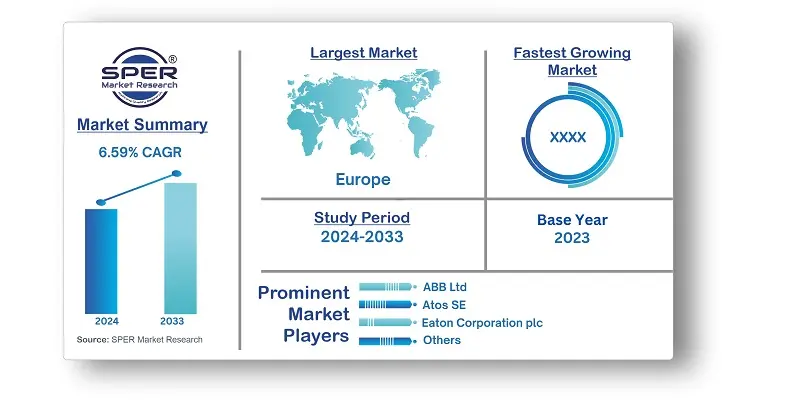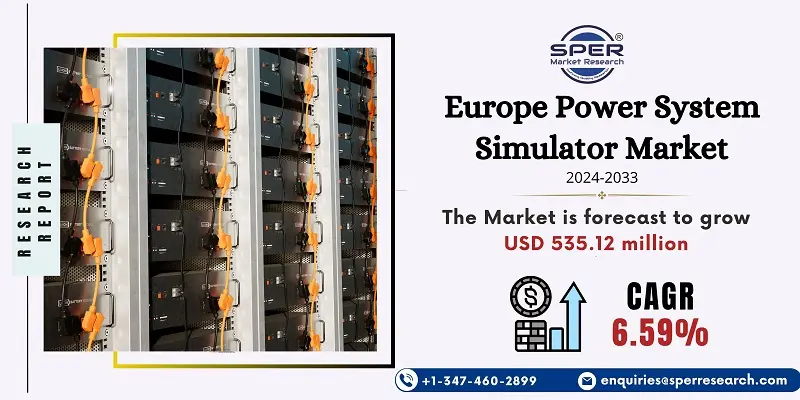
Europe Power System Simulator Market Growth, Size, Trends, Demand, Revenue and Future Outlook
Europe Power System Simulator Market Size- By Module, By Component, By End User- Regional Outlook, Competitive Strategies and Segment Forecast to 2033
| Published: Aug-2024 | Report ID: POAE2474 | Pages: 1 - 158 | Formats*: |
| Category : Power & Energy | |||
- In June 2021, Fuji Electric Co., Ltd. will offer the 7500WX Series, a high-capacity uninterruptible power supply system.
- Siemens provides a wide range of simulation tools, including the PSS® family of software solutions. Siemens simulators offer advanced capabilities for power system analysis, optimisation, and control. The company has concentrated on incorporating artificial intelligence (AI) and machine learning (ML) techniques into their simulations to improve system monitoring, predictive analytics, and decision-making support.


| Report Metric | Details |
| Market size available for years | 2020-2033 |
| Base year considered | 2023 |
| Forecast period | 2024-2033 |
| Segments covered | By Module, By Component, By End User |
| Regions covered | Germany, France, Italy, UK, Russia, and the Rest of Europe |
| Companies Covered | ABB Ltd, Atos SE, Eaton Corporation plc, Energy Exemplar, ETAP, Fuji Electric Co, Ltd, General Electric Company (GE), Neplan AG, OPAL-RT Technologies, Inc, Open Systems International, Inc (OSI), PowerWorld Corporation, RTDS Technologies Inc, Schneider Electric SE, Siemens AG. |
- Utility Companies
- Power Plant Operators
- Grid Operators
- Government and Regulatory Bodies
- Engineering and Consulting Firms
- Educational and Research Institutions
- Industrial and Manufacturing Companies
- Software and Technology Providers
- Renewable Energy Companies
- Investors and Financial Institutions
| By Module: |
|
| By Component: |
|
| By End User: |
|
- Europe Power System Simulator Market Size (FY’2024-FY’2033)
- Overview of Europe Power System Simulator Market
- Segmentation of Europe Power System Simulator Market By Module (Load flow, Harmonics, Short circuit, Device Coordination Selectivity, Arc Flash, Others)
- Segmentation of Europe Power System Simulator Market By Component (Hardware, Software, Services)
- Segmentation of Europe Power System Simulator Market By End User (Power, Industrial, Others)
- Statistical Snap of Europe Power System Simulator Market
- Expansion Analysis of Europe Power System Simulator Market
- Problems and Obstacles in Europe Power System Simulator Market
- Competitive Landscape in the Europe Power System Simulator Market
- Impact of COVID-19 and Demonetization on Europe Power System Simulator Market
- Details on Current Investment in Europe Power System Simulator Market
- Competitive Analysis of Europe Power System Simulator Market
- Prominent Players in the Europe Power System Simulator Market
- SWOT Analysis of Europe Power System Simulator Market
- Europe Power System Simulator Market Future Outlook and Projections (FY’2024-FY’2033)
- Recommendations from Analyst
1.1. Scope of the report1.2. Market segment analysis
2.1. Research data source2.1.1. Secondary Data2.1.2. Primary Data2.1.3. SPER’s internal database2.1.4. Premium insight from KOL’s2.2. Market size estimation2.2.1. Top-down and Bottom-up approach2.3. Data triangulation
4.1. Driver, Restraint, Opportunity and Challenges analysis4.1.1. Drivers4.1.2. Restraints4.1.3. Opportunities4.1.4. Challenges4.2. COVID-19 Impacts of the Europe Power System Simulator Market
5.1. SWOT Analysis5.1.1. Strengths5.1.2. Weaknesses5.1.3. Opportunities5.1.4. Threats5.2. PESTEL Analysis5.2.1. Political Landscape5.2.2. Economic Landscape5.2.3. Social Landscape5.2.4. Technological Landscape5.2.5. Environmental Landscape5.2.6. Legal Landscape5.3. PORTER’s Five Forces5.3.1. Bargaining power of suppliers5.3.2. Bargaining power of buyers5.3.3. Threat of Substitute5.3.4. Threat of new entrant5.3.5. Competitive rivalry5.4. Heat Map Analysis
6.1. Europe Power System Simulator Market Manufacturing Base Distribution, Sales Area, Product Type6.2. Mergers & Acquisitions, Partnerships, Product Launch, and Collaboration in Europe Power System Simulator Market
7.1. Europe Power System Simulator Market Size, Share and Forecast, By Module, 2020-20267.2. Europe Power System Simulator Market Size, Share and Forecast, By Module, 2027-20337.3. Load flow7.4. Harmonics7.5. Short circuit7.6. Device Coordination Selectivity7.7. Arc Flash7.8. Others
8.1. Europe Power System Simulator Market Size, Share and Forecast, By Component, 2020-20268.2. Europe Power System Simulator Market Size, Share and Forecast, By Component, 2027-20338.3. Hardware8.4. Software8.5. Services
9.1. Europe Power System Simulator Market Size, Share and Forecast, By End User, 2020-20269.2. Europe Power System Simulator Market Size, Share and Forecast, By End User, 2027-20339.3. Power9.4. Industrial9.5. Others
10.1. Europe Power System Simulator Market Size and Market Share
11.1. Europe Power System Simulator Market Size and Market Share By Region (2020-2026)11.2. Europe Power System Simulator Market Size and Market Share By Region (2027-2033)11.3. Germany11.4. France11.5. Italy11.6. UK11.7. Russia11.8. Rest of Europe
12.1. ABB Ltd12.1.1. Company details12.1.2. Financial outlook12.1.3. Product summary12.1.4. Recent developments12.2. Atos SE12.2.1. Company details12.2.2. Financial outlook12.2.3. Product summary12.2.4. Recent developments12.3. Eaton Corporation plc12.3.1. Company details12.3.2. Financial outlook12.3.3. Product summary12.3.4. Recent developments12.4. Energy Exemplar12.4.1. Company details12.4.2. Financial outlook12.4.3. Product summary12.4.4. Recent developments12.5. ETAP12.5.1. Company details12.5.2. Financial outlook12.5.3. Product summary12.5.4. Recent developments12.6. Fuji Electric Co Ltd12.6.1. Company details12.6.2. Financial outlook12.6.3. Product summary12.6.4. Recent developments12.7. General Electric Company (GE)12.7.1. Company details12.7.2. Financial outlook12.7.3. Product summary12.7.4. Recent developments12.8. Neplan AG12.8.1. Company details12.8.2. Financial outlook12.8.3. Product summary12.8.4. Recent developments12.9. OPAL-RT Technologies, Inc12.9.1. Company details12.9.2. Financial outlook12.9.3. Product summary12.9.4. Recent developments12.10. Open Systems International, Inc (OSI)12.10.1. Company details12.10.2. Financial outlook12.10.3. Product summary12.10.4. Recent developments12.11. PowerWorld Corporation12.11.1. Company details12.11.2. Financial outlook12.11.3. Product summary12.11.4. Recent developments12.12. RTDS Technologies Inc12.12.1. Company details12.12.2. Financial outlook12.12.3. Product summary12.12.4. Recent developments12.13. Schneider Electric SE12.13.1. Company details12.13.2. Financial outlook12.13.3. Product summary12.13.4. Recent developments12.14. Siemens AG12.14.1. Company details12.14.2. Financial outlook12.14.3. Product summary12.14.4. Recent developments12.15. Others
SPER Market Research’s methodology uses great emphasis on primary research to ensure that the market intelligence insights are up to date, reliable and accurate. Primary interviews are done with players involved in each phase of a supply chain to analyze the market forecasting. The secondary research method is used to help you fully understand how the future markets and the spending patterns look likes.
The report is based on in-depth qualitative and quantitative analysis of the Product Market. The quantitative analysis involves the application of various projection and sampling techniques. The qualitative analysis involves primary interviews, surveys, and vendor briefings. The data gathered as a result of these processes are validated through experts opinion. Our research methodology entails an ideal mixture of primary and secondary initiatives.



Frequently Asked Questions About This Report
PLACE AN ORDER
Year End Discount
Sample Report
Pre-Purchase Inquiry
NEED CUSTOMIZATION?
Request CustomizationCALL OR EMAIL US
100% Secure Payment






Related Reports
Our Global Clients
Our data-driven insights have influenced the strategy of 200+ reputed companies across the globe.




















